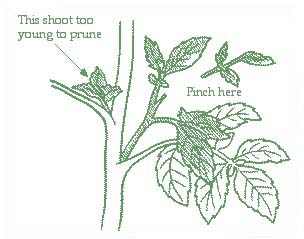
Cutting the plants back severely reduces yield, research shows

|
|
Here's a Cherokee Carbon hybrid tomato plant, in ground
about 4 weeks. At the most I'd trim off that shoot at lower
right, but not until the plant is bigger. And maybe not even then.
This is a good producer of purple-black tomatoes, and I want all the foliage -- and fruit -- I can get. (Photo: Kathy Morrison) |
Gardening has a lot of topics that provoke strong opinions among gardeners. Near the top has to be the idea of pruning tomato plants.
Over the years I've hardly pruned my plants at all. In fact, I never did until the first year I grew the hardy and prolific Juliet tomato. I was complaining to a friend that this plant was trying to take over the entire tomato bed, and she replied, "Well you know, you can prune them."
Since then, Juliet gets an occasional haircut, but the trims come only along the bottom. And that holds true for any other plant that aims to send rampant shoots across the garden.
But prune from the top? Horrors! A fellow community gardener asked me about that just today. And why would I want to cut off the growing tip of my plants? When the heat is coming and they need all the foliage they can get?
Some community gardeners do prune extensively, to a stake or a string, and then put shade cloth over the whole area to keep the tomatoes from being scorched. This seems to me like more work and less tomatoes. And I found University of California information that backs me up. Quoting here from the Integrated Pest Management website :
"Pruning your tomatoes
"Pruning is not always necessary. However, when pruning your tomatoes, remember these main points:
"Plants with two or more stems produce more tomatoes with better foliage protection from the sun than plants with one stem. However, tomatoes pruned to one leader will bear earlier but with less yield overall. Choose the stems you want to keep and pinch out the others as they develop. A dense leaf canopy may reduce the incidence of black mold and cracking but may increase the incidence of other fruit molds such as gray mold.

"Before removing suckers or side shoots on a tomato plant, wait until two leaves develop and pinch above them." (See graphic at right for illustration.)
This science-based information likely won't change the mind of anyone accustomed to pruning. Earlier tomatoes but less yield? No, I'll stick with my full-foliaged plants, thanks very much, and enjoy my crop when it does finally come in.
Comments
0 comments have been posted.Sacramento Digs Gardening to your inbox.
Sites We Like
Garden Checklist for week of May 12
Get your gardening chores and irrigation done early in the day before temperatures rise.
* Plant, plant, plant! It’s prime planting season in the Sacramento area. Time to set out those tomato transplants along with peppers and eggplants. Pinch off any flowers on new transplants to make them concentrate on establishing roots instead of setting premature fruit.
* Direct-seed melons, cucumbers, summer squash, corn, radishes, pumpkins and annual herbs such as basil.
* Harvest cabbage, lettuce, peas and green onions. This heat will cause leafy greens and onions to flower; pick them before they bolt.
* In the flower garden, direct-seed sunflowers, cosmos, salvia, zinnias, marigolds, celosia and asters.
* Plant dahlia tubers. Other perennials to set out include verbena, coreopsis, coneflower and astilbe.
* Transplant petunias, marigolds and perennial flowers such as astilbe, columbine, coneflowers, coreopsis, dahlias, rudbeckia and verbena.
* Keep an eye out for slugs, snails, earwigs and aphids that want to dine on tender new growth.
* Feed summer bloomers with a balanced fertilizer.
* For continued bloom, cut off spent flowers on roses as well as other flowering plants.
* Got fruit trees? If you haven't already done so, thin orchard fruit such as apples, peaches, pears, pluots and plums before they grow too heavy, breaking branches or even splitting the tree. Leave the largest fruit on the branch, culling the smaller ones, and allow for 5 to 6 inches (or a hand's worth) between each fruit.
* Thin grape bunches, again leaving about 6 inches between them. For the remaining bunches, prune off the "tail" end, about the bottom third of the bunch, so that the plant's energy is concentrated in the fruit closest to the branch.
* As spring-flowering shrubs finish blooming, give them a little pruning to shape them, removing old and dead wood. Lightly trim azaleas, fuchsias and marguerites for bushier plants.
* Add mulch to the garden to help keep that precious water from evaporating. Mulch also cuts down on weeds. But don’t let it mound around the stems or trunks of trees or shrubs. Leave about a 6-inch to 1-foot circle to avoid crown rot or other problems.